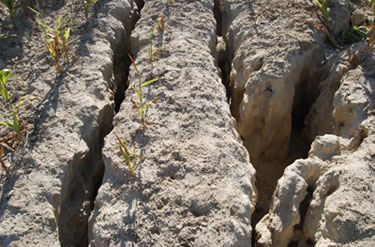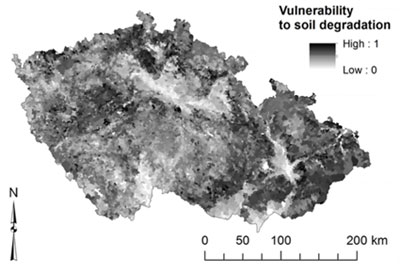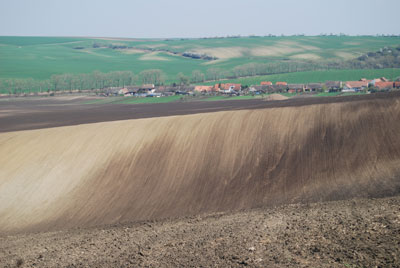January 5, 2015
Source: Crop Science Society of America
By Kaine Korzekwa
Soil is strong yet fragile, reliable yet unstable, and resilient yet susceptible to change.
These are all especially true when humans and their need for food enter the mix. Large amounts of evidence show soils are declining worldwide because of poor land use practices and soil management.
To study the issue of soil degradation in the Czech Republic, Borivoj Sarapatka and his team at Palacký University developed a way to model soil vulnerability by combining several indicators of soil degradation. Their work was recently published online in the Journal of Environmental Quality.

Extreme water erosion in a maize field. Photo courtesy of Borivoj Sarapatka.
Various organizations have performed long-term research throughout the Czech Republic on the individual factors that can damage soil. But no one has synthesized these findings into a model to illustrate the current state of Czech soil. Sarapatka and his team set out to combine different databases into a robust, comprehensive, and first-of-its-kind model.
To do this, the researchers identified two categories of degradation factors: physical and chemical. The physical factors consist of water and wind erosion and soil compaction. The chemical factors include heavy metal contamination, soil acidification, and loss of organic matter.
Their resulting map shows the levels to which soil degradation affects certain parts of the country. It can be used by different entities across the country when planning soil conversation and budgeting subsidies.
“The influence of degradation factors can be reduced by good agricultural practice, such as crop rotation, suitable machinery, and landscape management, which we have been working on together with other specialist organizations,” says Sarapatka.

A figure from the research paper showing total soil degradation threat in the Czech Republic. A darker color represents a higher vulnerability to soil degradation.
Soil degradation is closely related to agricultural production. It not only damages the environment but also harms farmers because it can reduce yields, he adds.
The new model integrates multiple aspects of soil degradation. It illustrates that water erosion is the largest overall factor in the Czech Republic. Water erosion affects about 51% of agricultural land, or about 5.4 million acres. Heavily farmed and damaged soils don’t have the structure they need to prevent their top layers from being washed or blown away. Wind erosion affects around 14% of agricultural land in the country. Research shows both forms of erosion are the result of poor management and climate change.
A third physical factor is soil compaction, which affects the rate at which water can pass through soil. This can lead to an increased risk of erosion. When water can’t be absorbed by the soil, it runs off instead, taking valuable topsoil with it. About 49% of agricultural land in the Czech Republic is threatened by soil compaction.
Soil acidification is a chemical factor of soil degradation. Data show that about 43% of Czech soils are threatened by acidification. Some plants cannot tolerate soils that are too acidic so the issue can be serious.

An agricultural landscape of south Moravia endangered by water erosion. Photo courtesy of Borivoj Sarapatka.
Fortunately, this specific factor is the easiest to limit, says Sarapatka. “In contrast to other types of soil degradation the issue of acidification of agricultural land is easier to resolve, by a thorough input of substances that can help lower the acidity level, which is a practice that has been quite abandoned in recent decades.”
Loss of organic matter, another chemical factor, is the second most serious problem affecting soils in the Czech Republic. Soil organic matter plays a large role in maintaining soil structure, stability, water retention, and soil biodiversity. It serves as a source of plant nutrients.
Soils can also become contaminated by various pollutants. The researchers warn that, although the problem isn’t currently large in the Czech Republic, it could increase by up to 50% without legislative changes.
Going forward, the researchers plan to use their model to help officials prioritize where to use soil-protection technologies. The model can aid in the planning of the future of farming in the Czech Republic.
“We provide not only research output, but this work is also applicable in practice in soil-protection activities,” says Sarapatka. ”Declining quality and degradation of soil are contemporary and urgent problems that need to be solved.”